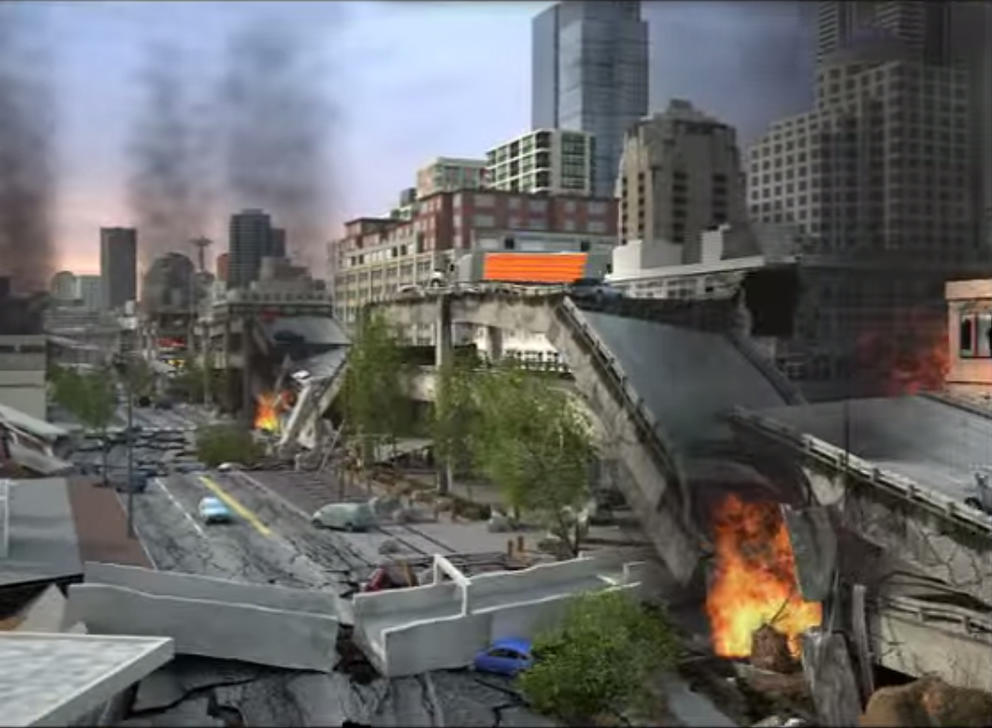When it comes to our pathetic lack of action on earthquake safety in some of our most-used buildings, you can’t really blame the infamous Seattle process. It’s more a lack of anyone having the courage to step forward and really lead on a complex issue.
So, if the Big One struck today, you could count on large numbers of us getting killed or trapped in pancaking older buildings. Offices, work places, apartments – a lot of the apartments are the more affordable ones sought out by both the young people the city wants to attract and the hard-working, lower-income residents the city is talking so loudly about supporting.
We have had plenty of reminders just in the past month that Seattle (along with Washington state as a whole) is pretty effectively ignoring the need to do more on preparing its older structures for earthquakes, and not just the largest ones, but also moderate ones. New Yorker feature writer Kathryn Schulz won a Pulitzer Prize for her article dramatically depicting the possible consequences of a major quake along the Cascadia subduction zone. A quake in Ecuador killed hundreds, many in just the types of older brick buildings that we live with. Dozens died in quakes in the southwest of Japan, the best prepared country in the world for earthquakes.
At the same time, Los Angeles released a preliminary map showing the older apartment buildings and condos where it will require landlords to retrofit in coming years (with an allowance for charging tenants up to $38 a month to help pay for the expensive work). Dramatically illustrating how little we’ve done here, a new Los Angeles rule deals with some wood-frame and concrete structures. California cities long ago addressed the brick ones that Seattle doesn’t require be made safer.
Eric Holdeman, perhaps the region’s foremost expert on emergency management, says of the Los Angeles-Seattle comparison, “We are so far behind the curve we are not even on the same race track.”
Indeed, the danger and the inaction is statewide. California put in place retrofitting requirements on unreinforced brick buildings about 20 years ago. He notes that a 2012 Washington state report only recommended a survey to identify at-risk buildings statewide — and nothing has happened. The report identifies the governor and members of the state Legislature as the people who would need to authorize a survey.
At least in Seattle, there has been a fair amount of process, especially after the 2001 Nisqually earthquake (there were even some regulations developed in the 1970s but they were repealed in the face of fierce opposition, according to Seattle Times science writer Sandi Doughton). But the city process, thanks to a push by former City Councilmember Richard Conlin a few years ago, could be getting us back to the point of looking seriously at the idea of requiring retrofits of older buildings. The city Department of Construction and Inspections has at least been plugging away on the issue, this month it posted an inventory of the most vulnerable brick or other unreinforced masonry structures (the buildings are identified by address here).
But don’t hold your breath waiting for the city to do something aggressive. The idea laid out on DCI’s web page on the issue envisions a proposed ordinance going to the Seattle City Council sometime this year. DCI spokesman Bryan Stevens says that 2017 would be more realistic, in large part because of an advisory panel that made some draft recommendations a few years ago will have to be reconvened and brought back up to speed on the issue. As he notes, too, the focus so far has only been on moderate earthquakes, roughly the size of the Nisqually earthquake.
If anything, the development of earthquake science since the advisory group’s January 2013 report screams out for quicker and more aggressive action. University of Washington Associate Professor Jeffrey Berman, an expert in engineering for earthquake safety, says that what we are learning about the Seattle, South Whidbey and Cascadia faults suggests that we are at as great a risk, perhaps greater, than California.
There is, though, a geologic factor: the more regular occurrence of moderate quakes that has probably helped California act more seriously. “We don’t have the kind of five-year reminder that they do,” Berman says.
While he's clear about the need for the city to require retrofitting, he acknowledges that there are complicating factors, especially costs for building owners. And costs also play into the issue of losing historic buildings if their owners can’t afford repairs. Plus, there’s the whole issue of affordable housing, although life saving benefits there would be the greatest, too, in a major quake.
One of the hottest business areas in Seattle is Pioneer Square, where many of the buildings are unreinforced masonry (as are many of the buildings in one of the city’s hottest entertainment districts, Ballard, according to the city assessment). For all the concern about imposing costs on businesses and property owners, there’s also the financial realities that would follow a major earthquake. Even now, buildings here, Berman says, are generally built just to ensure inhabitants get out alive, not that the buildings can be used again any time soon (hospitals and other critical facilities generally choose to engineer their facilities to higher standards).
He says the 2011 Christchurch quake that killed 185 people also closed the New Zealand city’s central business district for a year. He wonders how Seattle would respond to having Pioneer Square blocked off for a year.
Holdeman, who was formerly director of emergency management for King County, says one part of the reaction would be to pass a law requiring retrofits of older buildings. “I always say, If there is a law or a regulation that you are going to pass immediately after the next disaster, why do you have to wait?”
In this case, there is at least one pretty fair way to answer: No one has dragged the city or the state past discussion and into action.



